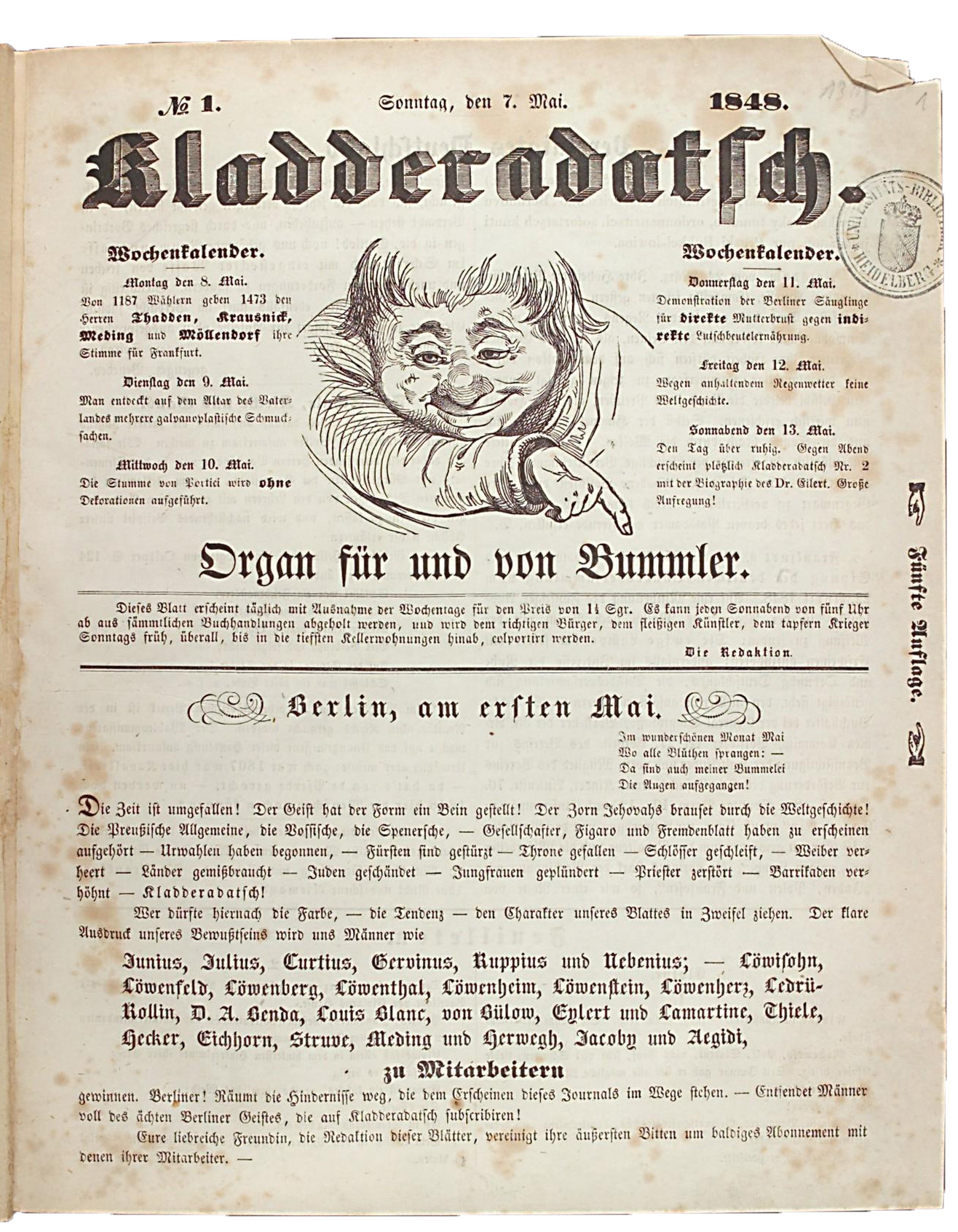Kladderadatsch 1875 - Zwischen Berlin und Rom.png on:
[Wikipedia]
[Google]
[Amazon]
 ''Kladderadatsch'' (
''Kladderadatsch'' (
, Spartacus Educational, Retrieved 27 March 2008. Publication ceased in 1944.
{{DEFAULTSORT:Kladderadatsch Defunct magazines published in Germany German-language magazines Satirical magazines published in Germany Magazines established in 1848 Magazines disestablished in 1944 Magazines published in Berlin 1848 establishments in Germany 1944 disestablishments in Germany Conservative magazines published in Germany
 ''Kladderadatsch'' (
''Kladderadatsch'' (onomatopoeic
Onomatopoeia is the process of creating a word that phonetically imitates, resembles, or suggests the sound that it describes. Such a word itself is also called an onomatopoeia. Common onomatopoeias include animal noises such as ''oink'', ''m ...
for "Crash") was a satirical
Satire is a genre of the visual, literary, and performing arts, usually in the form of fiction and less frequently non-fiction, in which vices, follies, abuses, and shortcomings are held up to ridicule, often with the intent of shaming or e ...
German-language magazine first published in Berlin on 7 May 1848. It appeared weekly or as the ''Kladderadatsch'' put it: "daily, except for weekdays." It was founded by Albert Hofmann and David Kalisch
David Kalisch (also known under the pseudonym: D. J. Schalk; February 23, 1820 – August 21, 1872) was a German playwright and humorist.
Early life
His infancy and early childhood were spent in a home of comfort and culture; but when he was onl ...
, the latter the son of a Jewish merchant and the author of several works of comedy."''Kladderadatsch'', Spartacus Educational, Retrieved 27 March 2008. Publication ceased in 1944.
Background
The first edition, written almost entirely by Kalisch, saw 4,000 copies printed, all of which were sold within 24 hours. Two other writers,Ernst Dohm
Friedrich Wilhelm Ernst (or Ernest) Dohm (born Elias Levy Dohm; also known by his pseudonym ''Karlchen Mießnick''; 24 May 1819, Breslau – 5 February 1883, Berlin) was a German editor, actor, and translator.
He was Jewish and a convert to Chri ...
and Rudolf Löwenstein, were then employed. Wilhelm Scholz's drawings appeared in the second edition, and would do so for the next 40 years. The magazine sold 50,000 copies in 1890 and 85,000 copies in 1911.
Originally, the ''Kladderadatsch'' was a liberal magazine, but grew more conservative over the years. During the Bismarck era, the journal supported the Chancellor's policies; during the Weimar era, its stance was German-nationalist. After the 1923 takeover by the industrialist Hugo Stinnes, the magazine's contents became increasingly right-wing and showed some sympathy with Hitler and National socialism
Nazism ( ; german: Nazismus), the common name in English for National Socialism (german: Nationalsozialismus, ), is the far-right politics, far-right Totalitarianism, totalitarian political ideology and practices associated with Adolf Hit ...
. The magazine adopted an aggressive satirical approach towards the Jews after 1933 in line with the Nazi magazine ''Die Brennessel
''Die Brennessel'' (German: ''Stinging Nettle'') was a weekly satirical magazine which was published in Munich, Germany, between 1931 and 1938. It was one of the publications which were established to gain popularity among Germans in favor of the ...
''.
References
External links
* * All issues of the ''Kladderadatsch'' in digitized form (pdf) available at the University of Heidelbergbr>Library: Kladderadatsch (1848-1944){{DEFAULTSORT:Kladderadatsch Defunct magazines published in Germany German-language magazines Satirical magazines published in Germany Magazines established in 1848 Magazines disestablished in 1944 Magazines published in Berlin 1848 establishments in Germany 1944 disestablishments in Germany Conservative magazines published in Germany